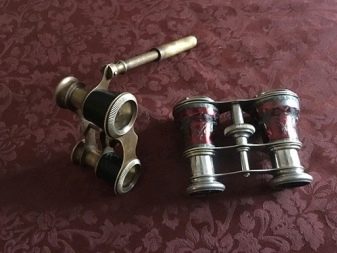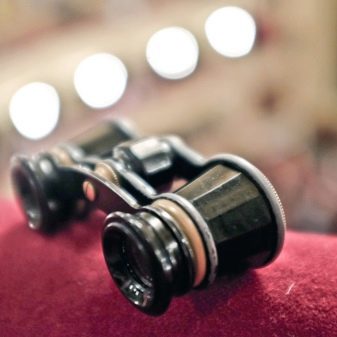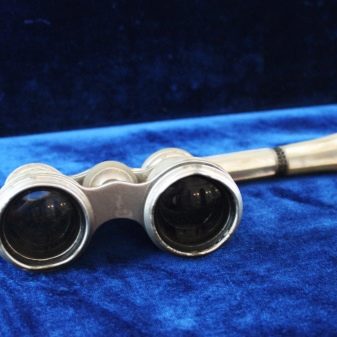Features and selection of theater binoculars

When attending public events, many people were faced with the fact that, due to the large number of spectators, it was impossible to come closer to the stage. It also happens that the purchased seats in the hall are too far from the stage, which makes it difficult to see the actors' play.
In these and other similar situations, the solution to the problem is the purchase of theater binoculars - a compact optical device with a small magnification.


What it is?
Binoculars for a theater are not a fake accessory; the device is really capable of magnifying objects that are at some distance from the observing person. If we compare such a device with other devices of a similar type, the size of its approximation will be the smallest, so it has its own specific application.
Theatrical binoculars are an optical device that people use primarily for attending events, such as going to the theater, circus, or sporting events.... The characteristics of the magnification level of the device are also very convenient for using it during tourism and travel - a small approximation is enough for contemplating beautiful landscapes and attractions.


Binoculars can be adjusted by turning the handwheel and focusing the lens on the desired object... The devices are manufactured in a wide range of colors and body shapes, the magnification level in them is from 2.2 to 4 times. The minimum magnification allows viewing objects that are at a distance of at least 1 meter from the viewer. A zoom level of 4 times assumes a view of objects at a distance of 2 meters or more.
A low level of magnification gives theater devices another advantage - a large field of view. This characteristic is very important for the audience, because when watching performances or sporting events, it is very important not to miss the details.


History of origin
The first optical devices intended for spectators of various events were large, heavy and not very comfortable. This optics was a slightly simplified telescope in which small monoculars were installed. To give the entertainment devices individuality, they were decorated with decorative enamel, stones and carvings.
Entertainment optics changed significantly at the end of the 18th century, when the Austrian entrepreneur Christoph Vogtländer founded a company for the production of high-precision optical products. The factory was the first to start producing comfortable binoculars for theaters in 1823, which is why already in the first half of the 19th century, the devices began to be in great demand. At that time, optics was not yet technically perfect, but compared to the old bulky telescopes, it clearly performed its function better.


The first theater binoculars were still heavy for constant monitoring of the stage, so they were made with a special handle. This design is called "lorgnette", it is convenient because the audience does not need to keep their hands to their faces all the time. Optics also had its drawbacks - distortions, called aberrations, made the visible image blurry.
New improvements to theatrical binoculars came at a time when inventor Pierre Lumière created the center focus. Equally important was the invention of Ernst Abbe - achromatic lenses, which also made important improvements in optical instruments. These two innovations have been complemented by the binocular prisms created by Abbe and Koening - together the inventions have significantly improved the quality of the enlarged image. At this point, theater binoculars became compact, lightweight, comfortable, and with a high level of precision - just like they can be found in a specialty store today.


Views
Theater binoculars are in great demand nowadays, so manufacturers create a huge range of models with different designs and additional functionality. Devices differ in the appearance of the case: products are available with chrome or gold finish, enamel surface, lacquer coating and with retro-styling. There are also modern, more economical versions of devices made of multi-colored plastic. Among lovers of such accessories, binoculars with a futuristic design, reminiscent of models from science fiction films, are popular.
Optical instruments are very sensitive to damage and contamination of lenses, so special storage cases and covers for lenses and eyepieces are often sold with them.
Beautiful packaging and a variety of designs allow any customer to find a suitable product for themselves or choose a high-quality gift.


Among the models of "entertainment optics" there is even a small monocular - a model of the device with one eyepiece. Despite the fact that initially the monoculars were not intended for use in the theater, their small size and weight, together with the ability to mount on a tripod, make the device convenient for observing the stage.
Binoculars while watching performances should not cause discomfort to the audience, therefore, they are equipped with additional elements. On sale there are models on a stick, thanks to which the user can hold the device with one hand, resting his elbow on the armrest. There are also models with a folding and retractable handle - such products are called lorgnets.For safety, many theatrical binoculars are supplemented with a special chain - hanging the device around the neck, the viewer will definitely not lose or drop a fragile product on the floor.


Top manufacturers
When choosing binoculars, it is very important to rely on their performance and design, but the manufacturer also plays an important role. Knowing reliable brands that make high-quality optical devices will help you quickly choose the right product. We offer to consider the rating of the best manufacturers of binoculars for the theater.
- Veber... A Russian-made brand that manufactures expensive high-quality optics.

- Sturman... A Chinese manufacturer offering medium-cost theater instruments with good quality optical elements.

- Levenhuk... A brand from the United States, produces expensive products with an impressive configuration and an almost life-long service life.

- Bresser... The German brand creates high-quality and convenient long-range vision devices with beautiful packaging that can replace a gift box.

- Kenko... The company from Japan, manufactures a wide range of quality optical instruments with beautiful designs and pollution protection.

- Eschenbach... The German manufacturer produces theater binoculars of the highest quality, which are not inferior in functionality and beauty to their competitor - the American company Levenhuk.

Criterias of choice
Many modern optical instruments still use a simplified Galilean design, which uses only two pairs of lenses - positive for the objective and negative for the eyepiece. The simple design of the mechanism ensures lightness and compactness, however, the image quality suffers greatly. The Galilean scheme renders the picture worse due to chromatic aberration. Some theater binoculars are equipped with focusing with a special flywheel, which immediately adjusts both sides of the device. These characteristics can be uncomfortable for those with varying visual acuity.
For such people, there is an advanced class of optical devices in which each part can be adjusted separately. The modern market offers a huge assortment of different theater binoculars, so choosing the right item becomes difficult. The advice of professionals studying optical products will help make the task easier. We suggest that you familiarize yourself with the list of criteria that will allow you to make a good purchase for visiting theaters and sports competitions.


Multiplicity
The magnification is the maximum magnification of objects that an optical device is capable of.... In theatrical apparatus, the magnification varies from 2 to 5 times, which provides the best view within a radius of 50 meters from the observer. This distance is enough to see the production clearly enough and at the same time to see all the events taking place on the stage in full.
For a better understanding of the plot and story, viewers do not need to consider the features of the actors' makeup, so a 2-4x magnification is sufficient. In addition, if you use a small amount of magnification, the picture will not be blurred with slight shake or movement of the hands.
This characteristic significantly distinguishes theater binoculars from more powerful units.

Aperture and no distortion at the edges
Theatrical performances, concerts and performances focus the audience's attention on the stage with the help of bright lighting, but at the same time, there is no lighting in the auditorium. In order for theatrical binoculars to accurately transmit the picture during the performance, it is necessary to choose a technique with a good antireflection coating, glare protection and a suitable level of brightness. The most optimal aperture characteristic is from 3 to 4.5.

Objective diameter
To capture the entire scene with a glance, you need a wide angle of view, so it is best not to choose binoculars with lenses less than 20 mm. Many spectators using a theatrical optical device claim that the best objective lens diameter for this purpose is 25-30mm.

Dimensions and weight
Modern theater binoculars are made in such a way that while watching the performance, the audience felt as comfortable as possible and imbued with the plot of the performance. The best performance for "entertainment optics" is its compact size and light weight.
The small device fits easily into a purse or a men's jacket pocket, and the light weight will not cause discomfort while watching the show.


Close focusing distance
It is never possible to predict in advance in which row the tickets for the show you are interested in will remain, therefore binoculars should be chosen with the ability to adjust. A close focusing distance of 1 to 4 meters is great for watching theatrical performances.
Such characteristics allow you to watch the performance both from the row close to the scene and from the gallery, you just need to correctly configure the device.









